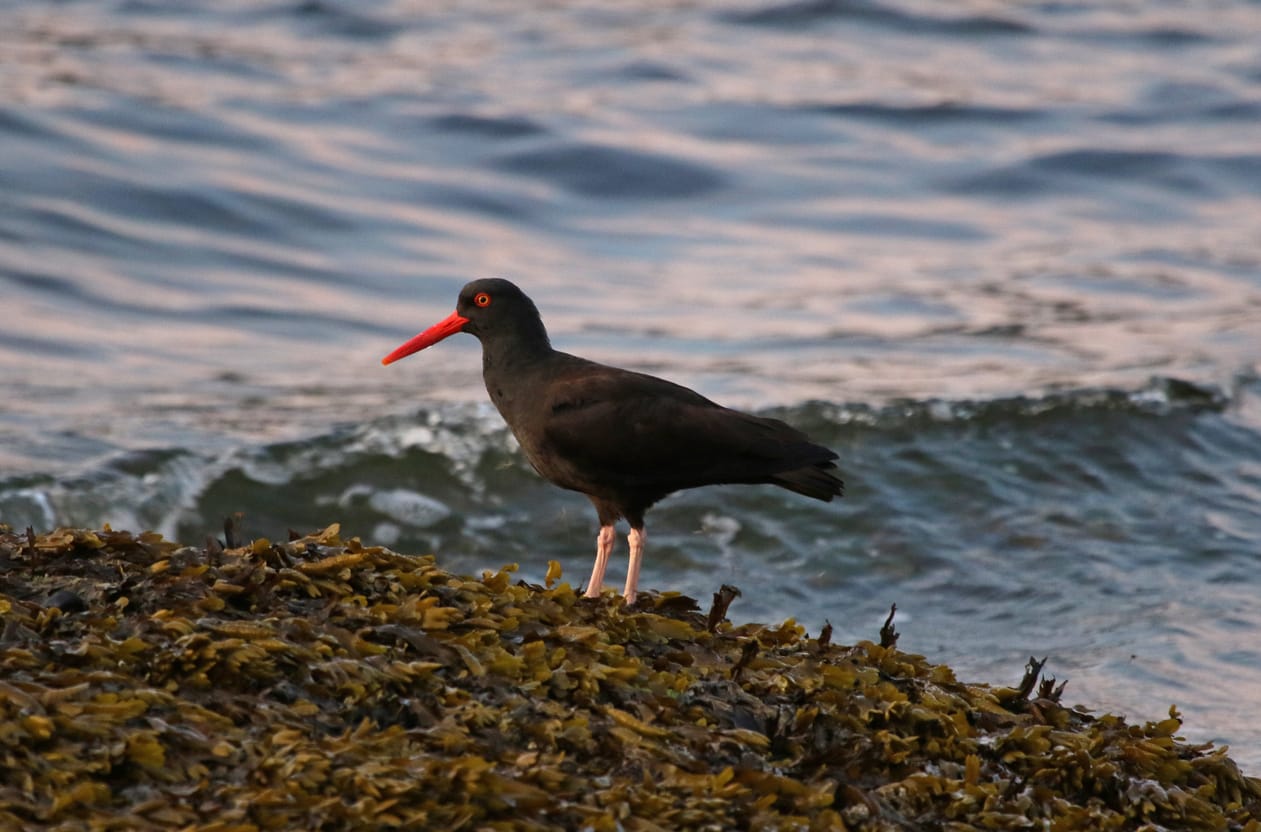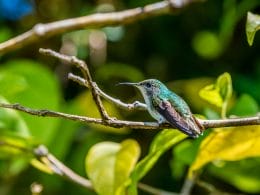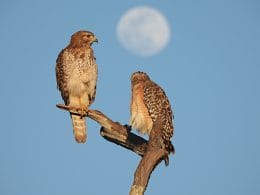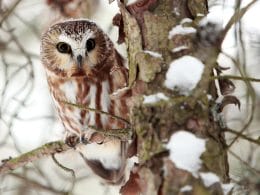California’s coastline measures 840 miles and ranks as the third-longest one in the US. In addition to enjoying the sunny beaches of California, there’s an excellent chance for birdwatchers to find tens of amazing seabirds.
These birds are highly adapted to nesting and living in coastal habitats, so keep on reading to learn more about these amazing creatures.
14 Amazing Seabird Species to Find in California
Here are 14 wonderful seabirds to look out for in California.
1. Common Loon

- Scientific name: Gavia immer
- Length: Between 26 and 36 inches
- Weight: Between 4.9 and 16.8 pounds
- Wingspan: Between 4.17 and 4.83 feet
The Common Loon is one of the longest living seabirds, where some individuals can live more than 30 years. It has a black head and bill with a spotted back.
Top Tip: It’s plumage turns gray between September and March, and it’s throat turns white.
Common Loons are strong seabirds and agile divers. This bird needs a runway of at least 30 yards to take off and can fly at a speed that measures up to 70 miles per hour.
It travels to California and the Mexican coastline in winter and rarely spends its time on land except to lay eggs.
2. California Brown Pelican

- Scientific name: Pelecanus occidentalis
- Length: Between 3.25 and 5 feet
- Weight: Between 4.4 to 11 pounds
- Wingspan: Between 6.6 and 7.5 feet
The Brown Pelican is a large seabird with a gray-brown body, a yellow head, and a white neck. It dives with a force that shocks the small fish before catching them.
It’s a year-round resident of California, mainly found on the Channel Islands, where the nests are built away from predators and humans. In the Southern California Bight, the Brown Pelican builds its nest on the ground, but it builds its nest on inaccessible slopes on Anacapa Island.
The California Brown Pelican can fly up to 40 feet away from the shore to find its prey and can eat up to 4 pounds of fish per day. It mainly feeds on anchovies, mackerel, sardines, and some crustaceans.
They are also common seabirds in Oregon.
3. Heermann’s Gull
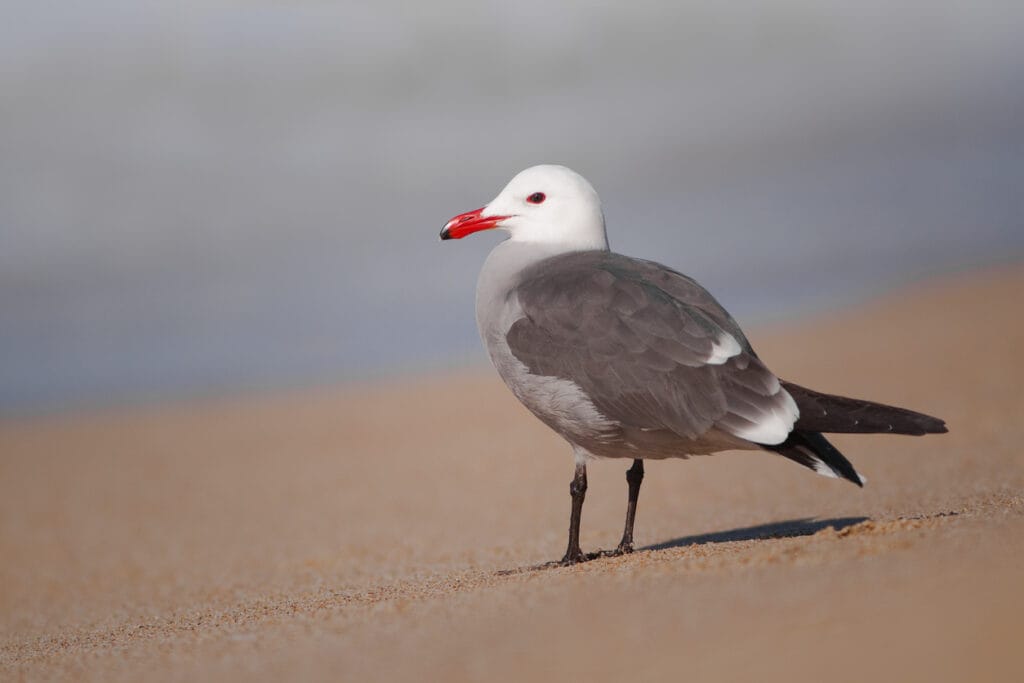
- Scientific name: Larus heermanni
- Length: Between 18.1 and 20.9 inches
- Weight: Between 13.1 and 22.7 ounces
- Wingspan: Between 40.9 and 45.3 inches
The Heermann’s Gull is a summer resident of California, where it can be found from June through September. It has a gray body with a pale gray below, a white head, and a bright red bill. Its white head makes it easy to distinguish from other gulls.
It’s seen with flocks of terns and other gulls and usually steals the catch of the Brown Pelican. This bird feeds on fish, crustaceans, marine invertebrates, and lizards and usually catches fish in flight.
Author Note: It prefers to nest on the rocky islands off the shores of California and moves north to Southern Canada when the breeding season is over.
4. Common Murre

- Scientific name: Uria aalge
- Length: Between 15 and 18 inches
- Weight: Between 1.67 and 2.75 pounds
- Wingspan: Between 24 and 29 inches
Also known as the Common Guillemot, the Common Murre is a year-round inhabitant of California, although it’s more common in summer. The bird has a blackish or brown head and underparts with a clear white belly. It indeed looks like a penguin, but these two species aren’t related.
The Common Murre usually sits on the surface of the water between dives and can dive deep up to 590 feet to catch its prey. It can also stay under the water for a couple of minutes.
It has fast wing beats with a speed that reaches up to 50 miles per hour, making a helicopter-like sound. Each year, the female lays a single egg, and eggs have different patterns to help Common Murres recognize their own.
5. Western Grebe

- Scientific name: Aechmophorus occidentalis
- Length: Between 22 and 30 inches
- Weight: Between 1.7 and 4.4 pounds
- Wingspan: Between 31 and 40 inches
The Western Grebe is black and white with a sharp transition along the neck, where most of the face is black. It has a greenish-yellow bill and red eyes. The feet are placed at the far back, which gives the bird a clumsy walk on land.
You can find the Western Grebe all year round in California, but it’s more abundant from September to May. Courting birds pair for a courtship display to attract females.
Because of its waterproof plumage, this bird was heavily hunted in the 19th century to make coats and caps. It usually swallows its own feathers when it preens, and these feathers line the stomach to protect it from the sharp fish bones.
6. Western Snowy Plover
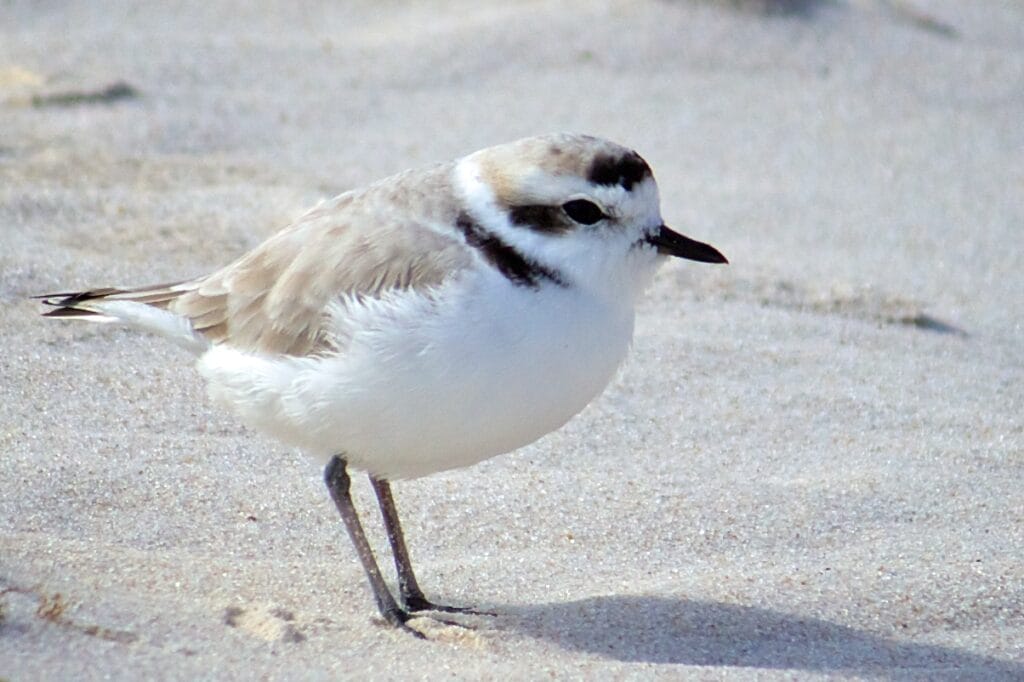
- Scientific name: Charadrius nivosus
- Length: Between 5.9 and 6.7 inches
- Weight: Between 1.1 and 2 ounces
- Wingspan: Between 13.4 and 17 inches
This small bird has a pale sandy brown top and white below. It can be found across the shores of California from March through September, with entire beaches along the Central California coastline protected as its nesting sites. These areas are completely restricted to humans to help preserve this shorebird’s population.
The Western Snowy Plover forages for crabs, clams, aquatic insects, and crustaceans along the sandy beaches, usually targeting wetter sand exposed by the tide. It’s an active forager, utilizing its sharp eyesight to spot its prey. To distract a predator that’s trying to attack its nest, it pretends that it has a broken wing.
7. Ashy Storm Petrel

- Scientific name: Hydrobates homochroa
- Length: About 8 inches
- Weight: About 1.3 ounces
- Wingspan: About 18 inches
The Ashy Storm Petrel is a gray-brown bird with a forked tail. It breeds on the islands off the coast of California, and it’s considered a threatened species with a global population of 10,000 individuals in its restricted range.
Top Tip: It feeds on fish and marine animals that come to the surface at night and nests in rocky burrows. Pairs mate for several years, although they spend their time separately during the non-mating season.
Local disasters like oil spills greatly impact the Ashy Storm Petrel. The bird’s breeding colonies are also facing the threats of mammalian predators like mice and cats.
8. Surf Scoter
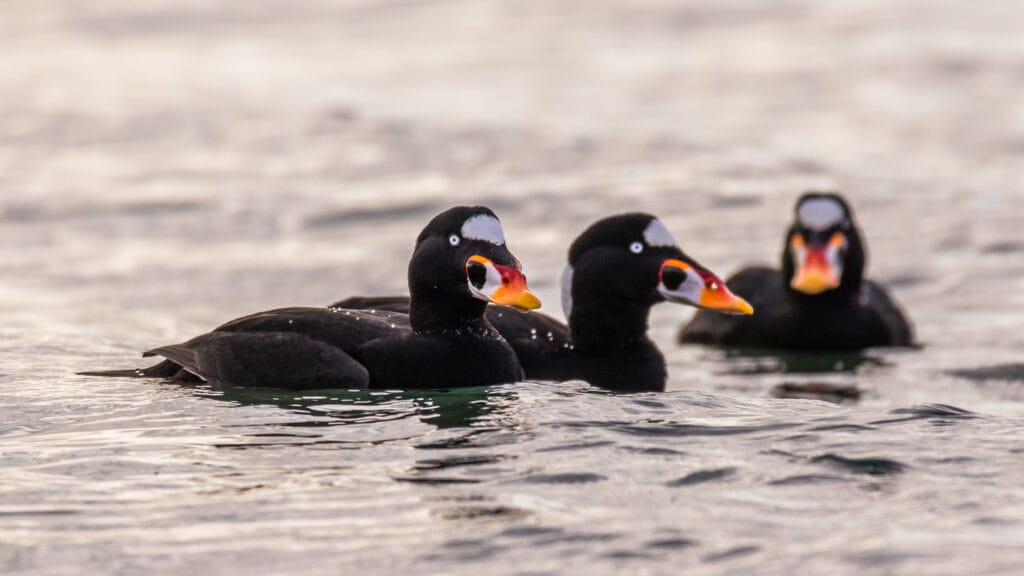
- Scientific name: Melanitta perspicillata
- Length: About 19 inches
- Weight: Between 2 and 2.3 pounds
- Wingspan: About 30 inches
The Surf Scoter is a winter inhabitant of the Californian Coast, especially between October and April. However, it can also be found in late September and early May.
Male birds are jet black with a white, orange, and black bill. Female birds are brown with gray bills, and both sexes have white patches on the forehead and back of the head.
This bird usually forages early or late in the day and feeds on mollusks, crustaceans, and marine invertebrates. It doesn’t breed in California but migrates north to Alaska and Canada, where it breeds near freshwater lakes.
9. Brandt’s Cormorant
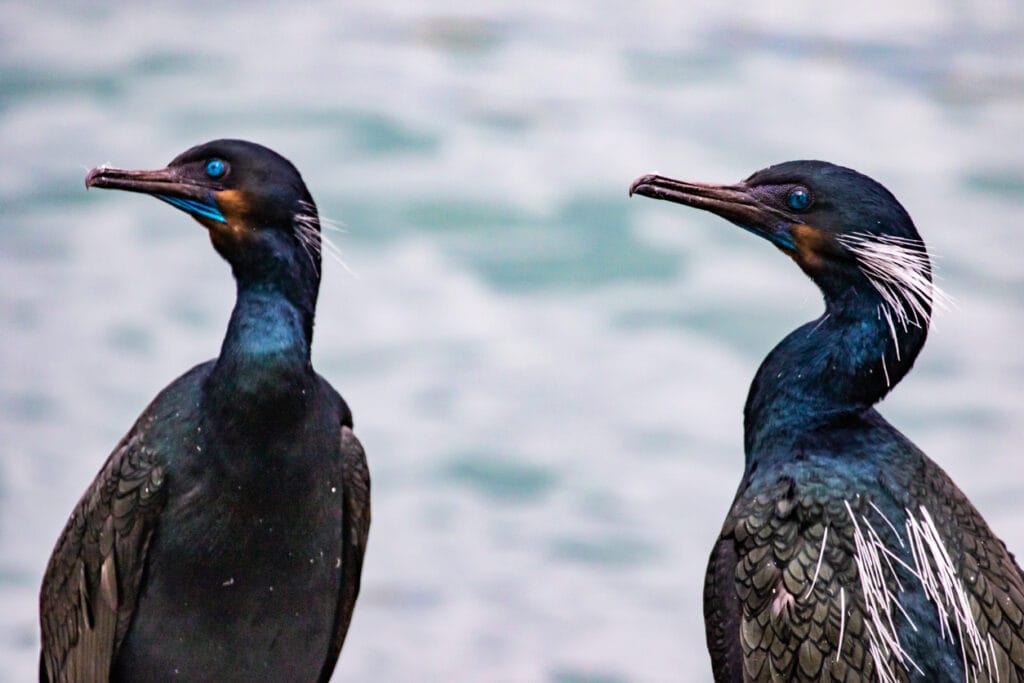
- Scientific name: Urile penicillatus
- Length: About 34 inches
- Weight: About 4.6 pounds
- Wingspan: About 4 feet
With a breeding range that stretches across the Pacific Coast, the Brandt’s Cormorant’s most significant breeding colony can be found on the San Miguel Island in Channel Islands National Park.
It’s a black bird with a bright cobalt-blue throat and some whiskery white feathers on the neck and shoulders.
Birds usually forage in large flocks, often with other seabirds and marine animals. They swim deeper than 200 feet to catch fish and shellfish from underwater structures.
You can see this seabird on the cliffs and offshore rocks. When it catches its prey, it crushes it with its bill and then swallows it headfirst. This bird targets fish schools and swims under them to drive the fish to the surface for easier capture.
10. Cassin’s Auklet
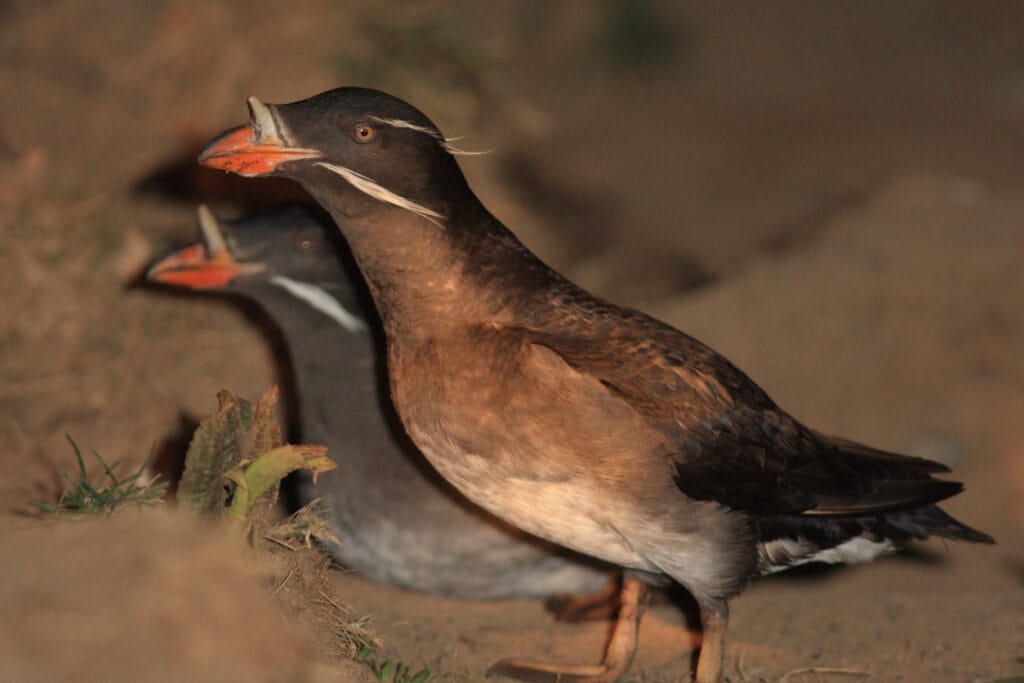
- Scientific name: Ptychoramphus aleuticus
- Length: About 9.1 inches
- Weight: Between 5.3 and 7.1 ounces
- Wingspan: About 24.4 inches
The Cassin’s Auklet is dark gray with a paler below and a whitish belly. It’s one of the residents of the Channel Islands, as this location provides the needed isolation that this bird needs to maintain its population.
Author Note: It’s not easy to spot this bird near land, as it usually returns to its nesting site late at night to avoid predators. But away from the shore, it’s easy to identify thanks to its tennis-ball flying style. It dives up to 100 feet to catch its prey.
It can be found in heavily dense colonies, where birds nest in rocky crevices and dig burrows. However, it usually picks sites away from bigger birds that might attack the nest and occupy it like the Rhinoceros Auklets.
11. Pigeon Guillemot
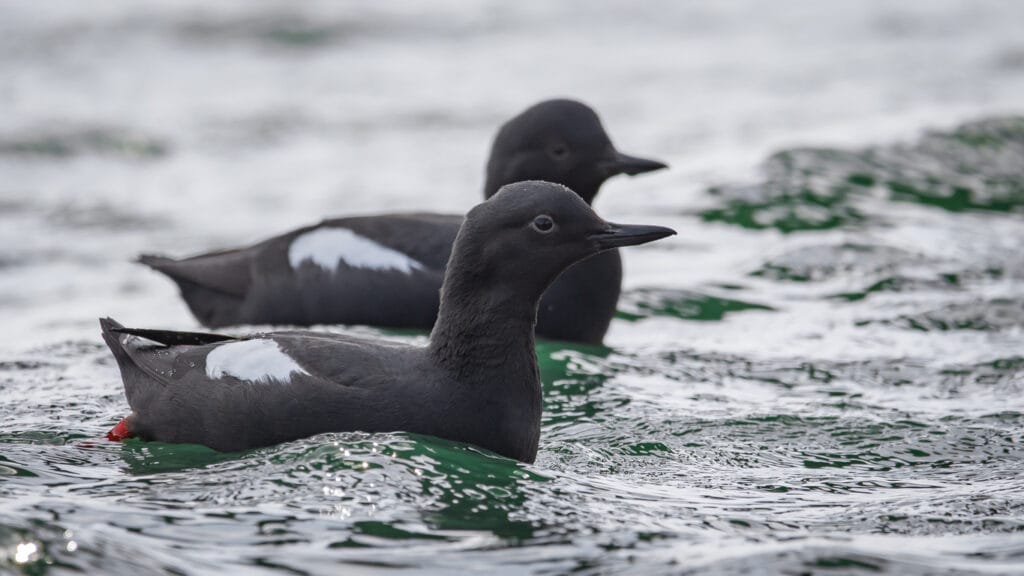
- Scientific name: Cepphus columba
- Length: Between 12 and 15 inches
- Weight: Between 16 and 19 ounces
- Wingspan: Between 21.6 and 23.2 inches
This crow-sized bird is almost dark brown with some white markings on the upper wings and red-orange legs, which male birds show off during the mating season.
The Pigeon Guillemot can be found in Monterey Bay on the Central Coast of California and in the Channel Islands National Park from February to late August.
It nests in rocky crevices and accepts man-made structures like pipes, where the female usually lays one or two eggs on the bare soil or on a bed made of seashells and pebbles.
It feeds on fish, crustaceans, and worms, and the parents usually bring one fish at a time to feed the young birds.
12. Scripps’s Murrelet

- Scientific name: Synthliboramphus scrippsi
- Length: About 6 ounces
- Weight: Between 16 and 19 ounces
- Wingspan: About 15 inches
The Scripps’s Murrelet is found along the coast of California and Mexico, with big colonies on the Santa Barbara Island, where almost 80% of the US population exists. It’s currently considered a threatened species because of oil spills.
It’s a small bird with a black body and a white below, and it usually feeds at sea but not far from land. It has strong wings that help propel it underwater to catch its prey.
This bird feeds in pairs and returns to its nest at night. However, unrelated pairs can also cooperate for feeding, as one member of a breeding pair will stay in the nest.
13. Black Oystercatcher
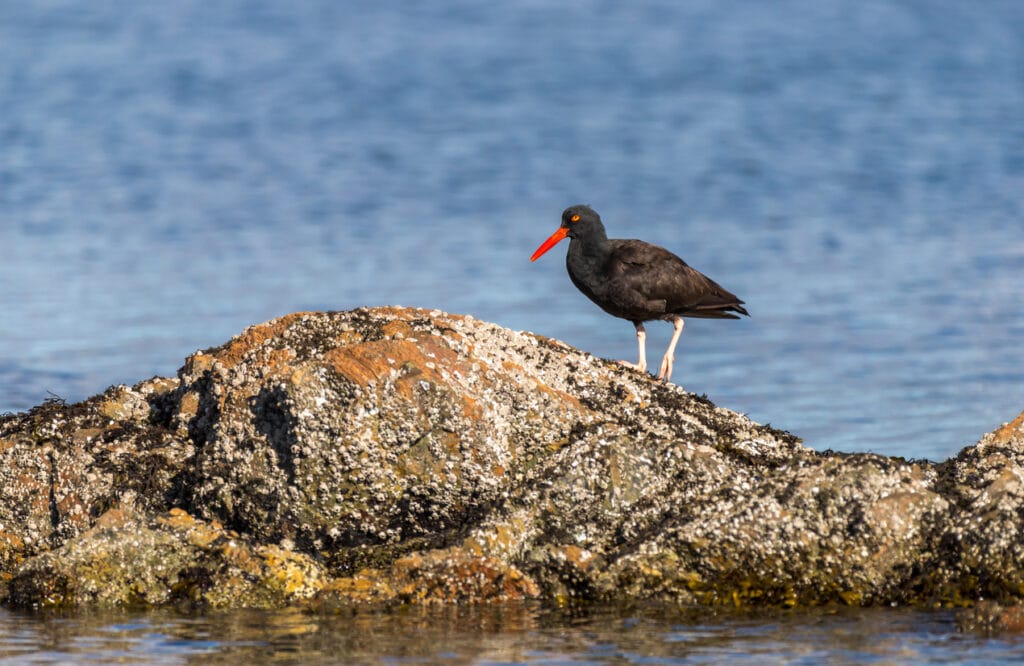
- Scientific name: Haematopus bachmani
- Length: Between 16.5 and 18.5 inches
- Weight: Between 17.6 and 24.7 ounces
- Wingspan: Between 28 and 36 inches
The Black Oystercatcher is a year-round resident of California, with black plumage, a bright orange-red bill, and pale pink legs. It can be found in the Channel Islands, where it prefers to reside on rocky shores.
It mainly feeds on crabs, clams, and limpets and rarely eats oysters despite its name. It uses its heavy bill to smash shells by cutting the adductor muscle that holds shells closed. This is why it’s usually seen walking slowly in low tide, looking for its prey.
You can easily spot this bird if you take a look at flat rocky reefs. It also has a distinctive whistled call.
14. Willet

- Scientific name: Tringa semipalmata
- Length: Between 13 and 16.1 inches
- Weight: Between 7 and 11.6 ounces
- Wingspan: About 27 inches
The Willet is a winter resident of California during its non-breeding season. It’s a large, stocky shorebird with gray or brown plumage and white and black stripes on the wings. In summer, the plumage becomes mottled.
This bird is often seen alone, walking on the rocky beaches to look for crabs, clams, and worms. It has a sensitive bill tip that helps it forage for food day and night and usually builds its nest close to the water edge. It can also be found along marshes and other inland wetlands.
In Conclusion
Whether you’re a resident of California or visiting the state for a vacation, there’s an excellent chance of seeing and studying several amazing seabirds along the state’s coastline.
Some of the species we mentioned in this article are only found in California, which makes it one of the most popular destinations for seabird lovers.
All you have to do is to have a sharp eye and perhaps go on a pelagic trip to get closer to these wonderful creatures. We hope you enjoyed our guide on California seabirds!
FAQ
An amazing 8 species of albatross have been reported off the coast of California. Some date back quite a while but 3 have been seen in the last year.
The most common small shorebird seen on Californian beaches is the Sanderling.
Terns are a much more elegant species of bird. At a glance or from a distance, they look a little like gulls. There are 9 species that can be seen along the coast of California.




